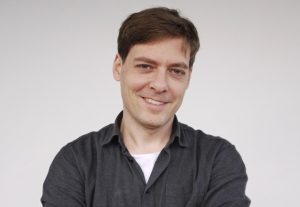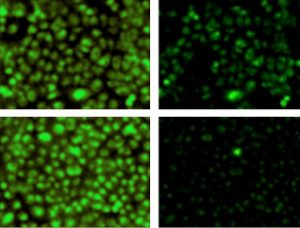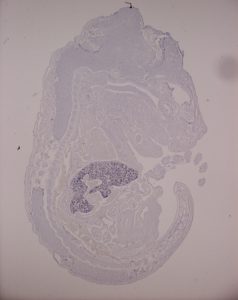
Welcome: Mallory Freeberg
The new Team Leader for Human Genomics at EMBL-EBI shares how curiosity and maths shaped her career and what it takes to be a community builder.
PEOPLE & PERSPECTIVES2024
people-perspectivesperspectives
Showing results out of

The new Team Leader for Human Genomics at EMBL-EBI shares how curiosity and maths shaped her career and what it takes to be a community builder.
PEOPLE & PERSPECTIVES2024
people-perspectivesperspectives

Blood stem cells from healthy people carry major chromosomal alterations, a study in Nature Genetics by researchers at the Max Delbrück Center and the European Molecular Biology Laboratory (EMBL) finds. The discovery suggests that we are all genetic mosaics, which may contribute to ageing-related…
SCIENCE & TECHNOLOGY2024
science-technology

A study from the Hackett group at EMBL Rome led to the development of an epigenetic editing system that allows to precisely program chromatin modifications at any specific position in the genome, to understand their causal role in transcription regulation.
SCIENCE & TECHNOLOGY2024
science-technology

The SARS-CoV-2 Data Hubs are a set of tools coupled with infrastructure that support four components: the submission, analysis, presentation and visualisation of SARS-CoV-2 raw read data, and its resulting analyses. What makes Data Hubs attractive is a unique set of features: A new publication in…
2024
updates-from-data-resources

The Lees group develops a tool that can scale up bacterial genome annotation.
2023
research-highlights

The Federated EGA is set to improve access to sensitive human data in a safe and secure way.
CONNECTIONS2022
announcementsconnectionsscience

EMBL researchers now understand the function of an elusive small DNA in bacteria and have developed a tool that can be used to better understand what might ‘switch on’ bacterial immune defences.
SCIENCE & TECHNOLOGY2022
sciencescience-technology

Researchers at EMBL Heidelberg found that inversions in the human genome are more common than previously thought, which impacts our understanding of certain genetic diseases.
SCIENCE & TECHNOLOGY2022
sciencescience-technology

Ewan Birney discusses the input of both genetics and our environment in making us who we are
LAB MATTERS2022
lab-mattersperspectives

Scientists urge the adoption of a sensible international policy for digital sequence information.
SCIENCE & TECHNOLOGY2022
announcementssciencescience-technology

Beautiful flashes of blue colour help light the way for researchers to study cells in fruit fly larva that provide oxygen to tissues.
SCIENCE & TECHNOLOGY2020
picture-of-the-weekscience-technology

A global team of researchers including the Flicek Team at EMBL-EBI has partnered up with the Māori tribe Ngātiwai to sequence the genome of the tuatara, a rare reptile endemic to New Zealand.
SCIENCE & TECHNOLOGY2020
sciencescience-technology

The human genome harbours about 19 000 protein-coding genes, many of which still have no known function. As scientists unveil the secrets of our DNA, they come across novel genes that they need to refer to using a unique name. The Human Genome Organisation’s Gene Nomenclature Committee (HGNC) at…
SCIENCE & TECHNOLOGY2020
sciencescience-technology

DNA damage caused by chemical mutagens is not repaired immediately and can create more genetic diversity in tumours.
SCIENCE & TECHNOLOGY2020
sciencescience-technology

DNA mutations are caused by a combination of DNA damage and repair, shows study by EMBL-EBI and collaborators.
SCIENCE & TECHNOLOGY2020
sciencescience-technology

New resource that categorises genes essential for supporting life could be used to identify rare disease mutations
SCIENCE & TECHNOLOGY2020
sciencescience-technology

Dame Janet Thornton presents the 2019 EMBL Insight Lecture: Ageing and disease – what is the link?
SCIENCE & TECHNOLOGY2020
eventsscience-technology
Funding awarded to EMBL-EBI for tuberculosis monitoring tool
SCIENCE & TECHNOLOGY2019
sciencescience-technology

What CRISPR may bring for the future of biology, and how it is used at EMBL
SCIENCE & TECHNOLOGY2019
sciencescience-technology

Nobel prize laureate Susumu Tonegawa describes his work in memory research over the past decade
LAB MATTERS2019
eventslab-matters

New EMBL group leader explores what neurobiology can teach us about what it means to be human
PEOPLE & PERSPECTIVES2019
people-perspectivesscience

A new database of bacteria in the human microbiome is the most comprehensive to date.
SCIENCE & TECHNOLOGY2019
sciencescience-technology

New search engine allows researchers to identify antibiotic resistance genes or mutations in real time
SCIENCE & TECHNOLOGY2019
sciencescience-technology

Enhancing the world's bioinformatics infrastructure
LAB MATTERS2019
lab-matters

What genetics can tell us about the structure of ancient human populations
PEOPLE & PERSPECTIVES2018
eventspeople-perspectives

New algorithm will enhance understanding of relationship between genotype and environmental factors
SCIENCE & TECHNOLOGY2018
sciencescience-technology
How embryonic stem cells develop into the germ line
SCIENCE & TECHNOLOGY2018
sciencescience-technology

Large-scale systematic analysis explores how inherited genome affects drug response of cancer cells
SCIENCE & TECHNOLOGY2018
sciencescience-technology
New computational method uses multi-omics analysis for personalised medicine
SCIENCE & TECHNOLOGY2018
sciencescience-technology
Of mice and gorillas: using mouse data for conservation
SCIENCE & TECHNOLOGY2018
sciencescience-technology

EMBL’s next Director General reflects on the questions that drive her research
PEOPLE & PERSPECTIVES2018
people-perspectivesscience

EMBL group leader Jan Korbel reflects on his scientific origins and current research
SCIENCE & TECHNOLOGY2018
sciencescience-technology

EMBL alumna, Èlia Benito-Gutiérrez, on how her research and career evolved after searching the seas
LAB MATTERSPEOPLE & PERSPECTIVES2018
lab-matterspeople-perspectives
Is depression in your genes?
SCIENCE & TECHNOLOGY2018
sciencescience-technology
Network of genes linked to development of diabetes
SCIENCE & TECHNOLOGY2018
sciencescience-technology

New group leader studies sea anemones to investigate why some animals regenerate better than others
PEOPLE & PERSPECTIVES2018
people-perspectivesscience

Curious about what goes on in EMBL’s Fly Room? Prepare to be a fly on the wall
LAB MATTERSPEOPLE & PERSPECTIVES2017
lab-matterspeople-perspectives

New group leader based in Grenoble aims to unveil the mechanisms of RNA editing
PEOPLE & PERSPECTIVES2017
people-perspectivesscience

Five things researchers have learned from bizarre fruit flies
SCIENCE & TECHNOLOGY2017
sciencescience-technology

IMPC explains how much the sex of animals is misdirecting research results
SCIENCE & TECHNOLOGY2017
sciencescience-technology

EMBL-EBI and IMPC characterised over 3000 mouse genes, revealing new gene associations with disease
SCIENCE & TECHNOLOGY2017
sciencescience-technology

EMBL-EBI researchers identify mouse epigenetic clock that could help scientists understand ageing
SCIENCE & TECHNOLOGY2017
sciencescience-technology

Researchers use single-cell sequencing to understand how cells age
SCIENCE & TECHNOLOGY2017
sciencescience-technology

Healing and anxiety are influenced by the genetics of one’s social partners
SCIENCE & TECHNOLOGY2017
sciencescience-technology

Paul Nurse’s failed experiment inspired a career that would uncover key mechanisms of cell division
SCIENCE & TECHNOLOGY2016
sciencescience-technology

EMBL’s Petra Riedinger retires after 40 years producing posters, graphics, artwork and more
LAB MATTERSPEOPLE & PERSPECTIVES2016
lab-matterspeople-perspectives

IMPC study identifies 410 genes essential to life in the mouse, providing a window on human disease
SCIENCE & TECHNOLOGY2016
sciencescience-technology

Emmanuelle Charpentier sheds light on how CRISPR–Cas9 went from side project to global revolution
SCIENCE & TECHNOLOGY2016
sciencescience-technology

Two PhD students sink their teeth into the science and speculations of Jurassic Park.
LAB MATTERS2015
eventslab-matters

1000 Genomes Project pushed technologies and knowledge forward to understand what is 'normal' human genetic variation
SCIENCE & TECHNOLOGY2015
sciencescience-technology

Missing a gene may not be a big deal – a conclusion from global catalogue of genetic changes.
SCIENCE & TECHNOLOGY2015
sciencescience-technology

EMBL-Wellcome Genome Campus events collaboration showcases open, application-based science.
CONNECTIONS2015
connectionsevents

EMBL scientists map ‘switches’ for distant control of gene expression.
SCIENCE & TECHNOLOGY2015
sciencescience-technology

Web of lies? Science Movie Night reveals science behind the most famous spider bite in film history.
LAB MATTERS2015
eventslab-matters

European team identify mechanism for producing piRNAs that silence jumping genes in germline cells.
SCIENCE & TECHNOLOGY2015
sciencescience-technology

Researchers at EMBL-EBI speed up complex GWAS analyses with new method and algorithm.
SCIENCE & TECHNOLOGY2015
sciencescience-technology

Decaying RNA molecules tell a story that could add more chapters to the study of ribosomes.
SCIENCE & TECHNOLOGY2015
sciencescience-technology

Exploring the science and magic of Lil Bub – alumna launches project to sequence the ‘Lilbubome’.
LAB MATTERS2015
alumnilab-matters

New microscopy-based method goes beyond gene sequencing, pinpointing the cause of disease.
SCIENCE & TECHNOLOGY2015
sciencescience-technology

EMBL-EBI supports relaunch of yourgenome.org, to bring genetics advances to a wider audience.
LAB MATTERS2015
lab-matters

Compound that can restore the function of poorly working mitochondria, with therapeutic potential.
SCIENCE & TECHNOLOGY2014
sciencescience-technology

Whether it’s information or people, the art of connecting is key to new group leader Judith Zaugg
PEOPLE & PERSPECTIVES2014
people-perspectivesscience

Experts from multiple fields come together to understand how the instructions in genes are read
SCIENCE & TECHNOLOGY2014
eventsscience-technology

EMBL-EBI hosts successful first EMBO Practical Course in Genotype to Phenotype Mapping.
SCIENCE & TECHNOLOGY2014
eventsscience-technology

Surprising finding: enhancers find their targets long before activation in Drosophila embryos
SCIENCE & TECHNOLOGY2014
sciencescience-technology

School ambassadors show next generation that scientists are more ‘role model’ than ‘mad professor’
LAB MATTERS2014
lab-matters

Scientists from EMBL's five sites reflect on the opportunities and challenges that might lie ahead
LAB MATTERS2014
lab-matters

Enabling neighbours: intact genes can cause cancer when placed near "enhancing" regions of DNA
SCIENCE & TECHNOLOGY2014
sciencescience-technology
How a DNA stretch influences face formation and contributes to common congenital malformations
SCIENCE & TECHNOLOGY2014
sciencescience-technology
Genome Campus researchers discover that some immune cells turn themselves off by producing a steroid.
SCIENCE & TECHNOLOGY2014
sciencescience-technology
Tsetse fly genome sequenced; scientists hope to find new ways to control sleeping sickness.
SCIENCE & TECHNOLOGY2014
sciencescience-technology

Scientists at the European Molecular Biology Laboratory (EMBL) in Heidelberg and Regensburg University, both in Germany, and the University of Lisboa, in Portugal, have discovered a promising potential drug target for cystic fibrosis. Their work, published online today in Cell, also uncovers a…
SCIENCE & TECHNOLOGY2013
sciencescience-technology
Gene expression wave in the lower part of the future vertebrae column of a mammalian embryo. As the wave goes forward, new pre-vertebrae are formed and the future vertebrae column elongates. (Image and video credit: Nature) In a nutshell: The size of pre-vertebrae in a mammalian embryo is…
SCIENCE & TECHNOLOGY2012
sciencescience-technology
In a nutshell : The gut metagenome is the collection of all the genomes of all the microbes in the human intestinal tract : it is specific to each human, like a second genetic signature At least in healthy humans, this personal metagenome is stable over time The gut metagenome is…
SCIENCE & TECHNOLOGY2012
sciencescience-technology
In a nutshell: 1st map combining human genetic variation at different scales – from single letters to large chunks Based on genomes of 1092 healthy people from Europe, the Americas and East Asia Could help identify genetic causes of disease, rather than just links Data made freely available in…
SCIENCE & TECHNOLOGY2012
sciencescience-technology

Scientists at the European Molecular Biology Laboratory (EMBL) in Heidelberg, Germany, have conducted the first comprehensive census of human cells’ export workers. In a study published online today in Nature Cell Biology, they found an unexpected variety of genes involved in transporting…
SCIENCE & TECHNOLOGY2012
sciencescience-technology

In one of the most famous faux pas of exploration, Columbus set sail for India and instead ‘discovered’ America. Similarly, when scientists at the European Molecular Biology Laboratory (EMBL) in Heidelberg, Germany, set out to find enzymes – the proteins that carry out chemical…
SCIENCE & TECHNOLOGY2012
sciencescience-technology

An inherited mutation in a gene known as the guardian of the genome is likely the link between exploding chromosomes and some particularly aggressive types of cancer, scientists at the European Molecular Biology Laboratory (EMBL), the German Cancer Research Centre (DKFZ) and the University…
SCIENCE & TECHNOLOGY2012
sciencescience-technology
A team of geneticists and computational biologists at the European Molecular Biology Laboratory’s European Bioinformatics Institute (EMBL-EBI), the Wellcome Trust Sanger Institute and Cancer Research UK reveal how an ancient mechanism is involved in gene control and continues to drive genome…
SCIENCE & TECHNOLOGY2012
sciencescience-technology

As an embryo develops, different genes are turned on in different cells, to form muscles, neurons and other bodily parts. Inside each cell’s nucleus, genetic sequences known as enhancers act like remote controls, switching genes on and off. Scientists at the European Molecular Biology Laboratory…
SCIENCE & TECHNOLOGY2012
sciencescience-technology

A fungus that lives at extremely high temperatures could help understand structures within our own cells. Scientists at the European Molecular Biology Laboratory (EMBL) and Heidelberg University, both in Heidelberg, Germany, were the first to sequence and analyse the genome of a heat-loving fungus,…
SCIENCE & TECHNOLOGY2011
sciencescience-technology
Scientists at the European Molecular Biology Laboratory (EMBL) in Heidelberg, Germany, have developed a new method for studying gene regulation, by employing a jumping gene as an informant. Published online today in Nature Genetics, the new method is called GROMIT. It enables researchers to…
SCIENCE & TECHNOLOGY2011
sciencescience-technology
Scientists at the European Molecular Biology Laboratory (EMBL) in Heidelberg, Germany, have developed a new method which enables researchers to label any protein of their choice with any of a wide variety of previously available compounds, in living cells, by introducing a single reactive…
SCIENCE & TECHNOLOGY2011
sciencescience-technology

Scientists at the European Molecular Biology Laboratory (EMBL) and the German Cancer Research Centre (DKFZ), both in Heidelberg, Germany, have developed a new method that uncovers the combined effects of genes. Published online today in Nature Methods, it helps understand how different genes can…
SCIENCE & TECHNOLOGY2011
sciencescience-technology
In our not-so-distant evolutionary past, stress often meant imminent danger, and the risk of blood loss, so part of our body’s stress response is to stock-pile blood-clotting factors. Scientists in the Molecular Medicine Partnership Unit (MMPU), a collaboration between the European Molecular…
SCIENCE & TECHNOLOGY2011
sciencescience-technology
A detailed analysis of data from 185 human genomes sequenced in the course of the 1000 Genomes Project, by scientists at the European Molecular Biology Laboratory (EMBL) in Heidelberg, Germany, in collaboration with researchers at the Wellcome Trust Sanger Institute in Cambridge, UK, as well as the…
SCIENCE & TECHNOLOGY2011
sciencescience-technology
The cells in the different parts of this video are always the same (grey), but, like actors using make-up to highlight different facial features, they have fluorescent labels that mark different cellular components in different colours: blue shows the nucleus, yellow shows tubulin (a component of…
SCIENCE & TECHNOLOGY2010
sciencescience-technology
The 1000 Genomes Project, a major international collaboration to build a detailed map of human genetic variation, has completed its pilot phase. The results are now published in the journal Nature and freely available through the European Molecular Biology Laboratory’s European Bioinformatics…
SCIENCE & TECHNOLOGY2010
sciencescience-technology

Researchers from the European Molecular Biology Laboratory (EMBL) in Heidelberg, Germany, and the Max-Planck Institute of Immunobiology Freiburg have identified a novel protein complex that regulates around 4000 genes in the fruit fly Drosophila and likely plays an important role in mammals, too.…
SCIENCE & TECHNOLOGY2010
sciencescience-technology

Red blood cells, the delivery men that take oxygen to cells all around the body, have short lives. To keep enough of them in circulation, the human body produces around 2 million of these cells every second – even more in response to challenges like severe blood loss. In a study published today…
SCIENCE & TECHNOLOGY2010
sciencescience-technology

During embryonic development, proteins called Polycomb group complexes turn genes off when and where their activity must not be present, preventing specialised tissues and organs from forming in the wrong places. They also play an important role in processes like stem cell differentiation and…
SCIENCE & TECHNOLOGY2010
sciencescience-technology

Name a human gene, and you’ll find a movie online showing you what happens to cells when it is switched off. This is the resource that researchers at the European Molecular Biology Laboratory (EMBL) in Heidelberg, Germany, and their collaborators in the Mitocheck consortium are making freely…
SCIENCE & TECHNOLOGY2010
sciencescience-technology
Once the human genome was sequenced in 2001, the hunt was on for the genes that make each of us unique. But scientists at the European Molecular Biology Laboratory (EMBL) in Heidelberg, Germany, and Yale and Stanford Universities in the USA, have found that we differ from each other mainly because…
SCIENCE & TECHNOLOGY2010
sciencescience-technology
The thousands of bacteria, fungi and other microbes that live in our gut are essential contributors to our good health. They break down toxins, manufacture some vitamins and essential amino acids, and form a barrier against invaders. A study published today in Nature shows that, at 3.3 million,…
SCIENCE & TECHNOLOGY2010
sciencescience-technology

Is it a boy or a girl? Expecting parents may be accustomed to this question, but contrary to what they may think, the answer doesn’t depend solely on their child’s sex chromosomes. Scientists at the European Molecular Biology Laboratory (EMBL) in Heidelberg, Germany and the Medical Research…
SCIENCE & TECHNOLOGY2009
sciencescience-technology
Genetic recombination, the process by which sexually reproducing organisms shuffle their genetic material when producing germ cells, leads to offspring with a new genetic make-up and influences the course of evolution. In the current issue of Nature, researchers at the European Molecular…
SCIENCE & TECHNOLOGY2008
sciencescience-technology
Much less widely known than the dangerous consequences of iron deficiencies is the fact that too much iron can also cause problems. The exact origin of the genetic iron overload disorder hereditary hemochromatosis [HH] has remained elusive. In a joint effort, researchers from the European Molecular…
SCIENCE & TECHNOLOGY2008
sciencescience-technology
Drawing on the expertise of multi-disciplinary research teams, the map developed by the 1000 Genomes Project will provide a view of biomedically relevant DNA variations at a resolution unmatched by current resources. The European Bioinformatics Institute (EBI), working with long-term collaborator…
LAB MATTERS2008
lab-matters
Hormones control growth, metabolism, reproduction and many other important biological processes. In humans, and all other vertebrates, the chemical signals are produced by specialised brain centres such as the hypothalamus and secreted into the blood stream that distributes them around the body.…
SCIENCE & TECHNOLOGY2007
sciencescience-technology
No results found